Turtles are one of the oldest reptiles existing today. They are known to have been in existence for over 200 million years ago. There are also many species of turtles in existence. It is believed that there are about 260 turtle species globally. These species are not equally distributed as some states have more species than others.
Turtle distribution solely depends on the natural resources available. Since different species depend on different habitats, some states have more turtles than others. For instance, aquatic turtles will only be found in states with suitable water bodies, while terrestrial turtles depend largely on grasslands and woodlands.
So, how many turtle species are native to Alabama?
Alabama is among the areas with the number of turtle species. Due to the vast resources available, the state boasts of 30 different native turtle species. These turtles fall into three major turtle categories (Freshwater turtles (22 species), Box turtles (3 species), Sea turtles (5 species))
Alabama is home to 30 different turtle species, and they are:
- Common Snapping Turtle
- Alligator Snapping Turtle
- Painted Turtle
- Southern Painted Turtle
- Ouachita Map Turtles
- Alabama Map Turtle
- Black-knobbed Map Turtle
- Barbour’s Map Turtles
- Escambia Map Turtle
- Diamond-Backed Terrapin
- River Cooters
- Coastal Plain Cooter
- Alabama Red-Bellied Cooter
- Pond Slider
- Spiny Softshell Turtle
- Smooth Softshell Turtle
- Eastern Mud Turtle
- Eastern Musk Turtle
- Flattened Musk Turtle
- Razorback Musk Turtle
- Loggerhead Musk Turtle
- Chicken Turtle
- Eastern box turtle
- Three-toed box turtle
- Gopher tortoise
- Leatherback
- Green sea turtle
- Loggerhead
- Hawksbill
- Kemp’s ridley
Being in the same category does not necessarily mean that these turtles have similar characteristics. Some of them are pretty diverse. This article will explore the different species in each category and give their features and behaviors.
Freshwater Turtles
Freshwater turtles are those aquatic turtles found in any freshwater body. Technically, this means all water bodies apart from the sea. These turtles are the most abundant in Alabama. They include the following:
1. Common Snapping Turtle
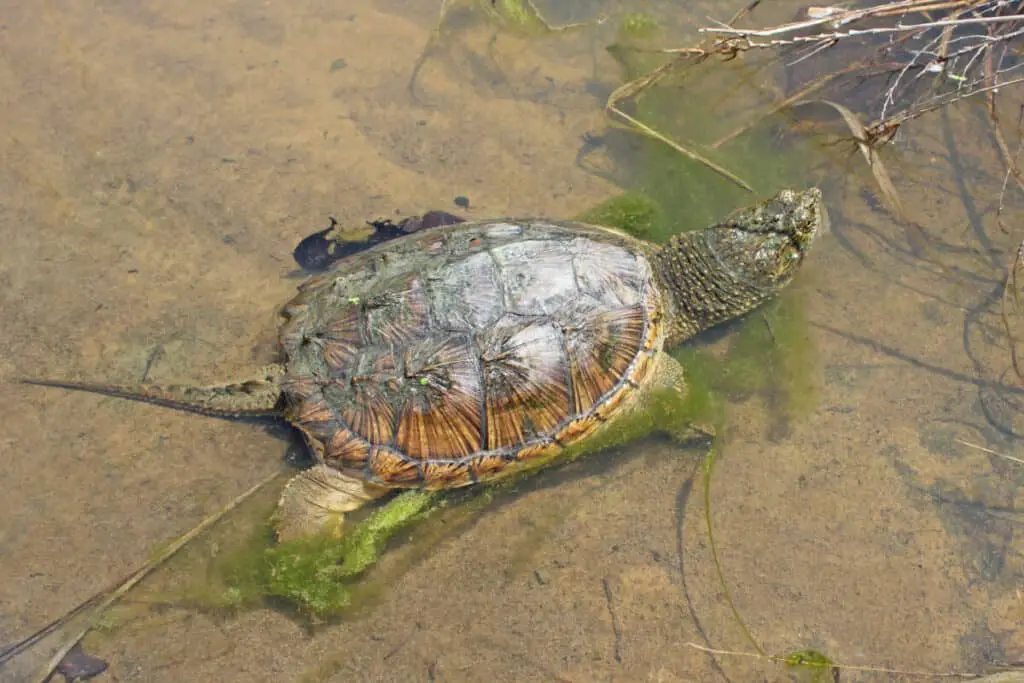
Scientific Name: Chelydra serpentina.
Description: The common snapping turtle has a black or brown carapace (upper shell) without any distinctive pattern.
Common snapping turtles are common marshes, ponds, rivers, and streams. They prefer slow-flowing water bodies with muddy or loose sandy bottoms and areas with dense vegetation for both food and cover.
Size: They can grow pretty big, achieving a length of 8 to 18.5 inches long when mature. Further, they have a big head and a thick long tail.
Diet: Common snapping turtles are omnivores and will feed on fish, frogs, insects, aquatic vegetation, and carrion.
Reproduction: Reproduction in common turtles starts between the 8th and 10th years. Each year, it begins in April and ends in November, although this may vary slightly. After a female lays eggs, incubation takes about 80 days.
Lifespan: The lifespan of a common snapping turtle is 50 years in the wild.
2. Alligator Snapping Turtle
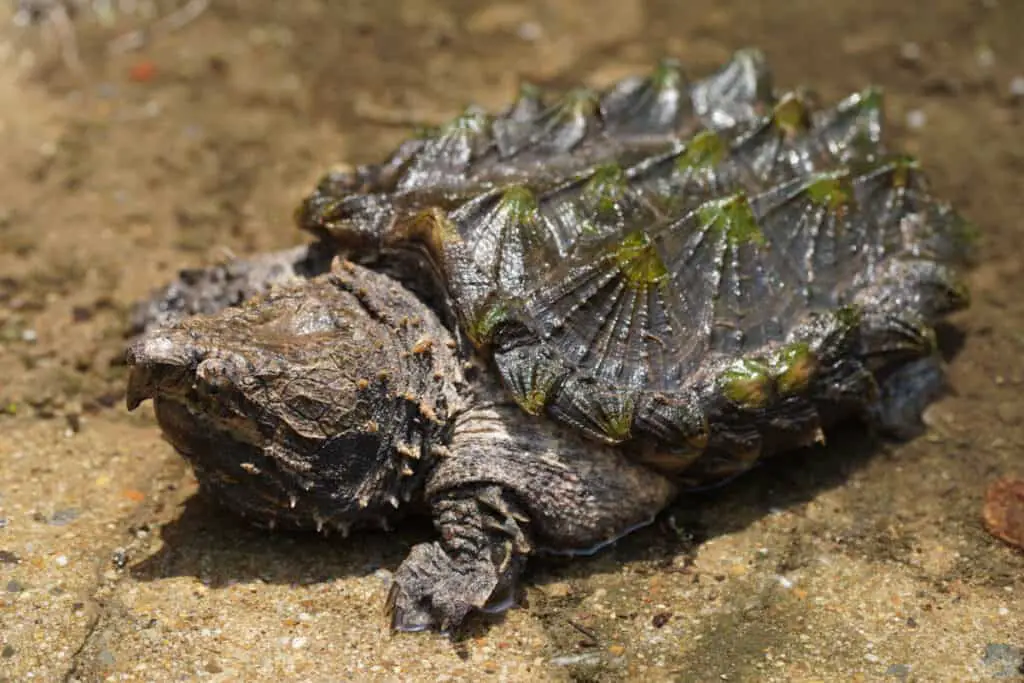
Scientific Name: Macrochelys temminckii.
Description: This turtle derives its name from the alligator-like features of its carapace. It has ridges all over its body like an alligator.
The carapace is either black, olive, or brown, while the tips of the ridges are green due to the accumulation of algae.
Alligator turtles are commonly found in deep canals, rivers, ponds, lakes, and swamps. These turtles are carnivorous and don’t actively hunt for prey. They lay at the bottom of the floor of a water body and ambush any prey that draws close. Their jaws are powerful and can cause serious harm.
Size: It is the largest of all freshwater turtles in Alabama at between 15 and 20 inches long.
Reproduction: Nesting in these turtles happens between May and July. After female turtles lay eggs, it takes about 80 days for them to hatch.
3. Painted Turtle
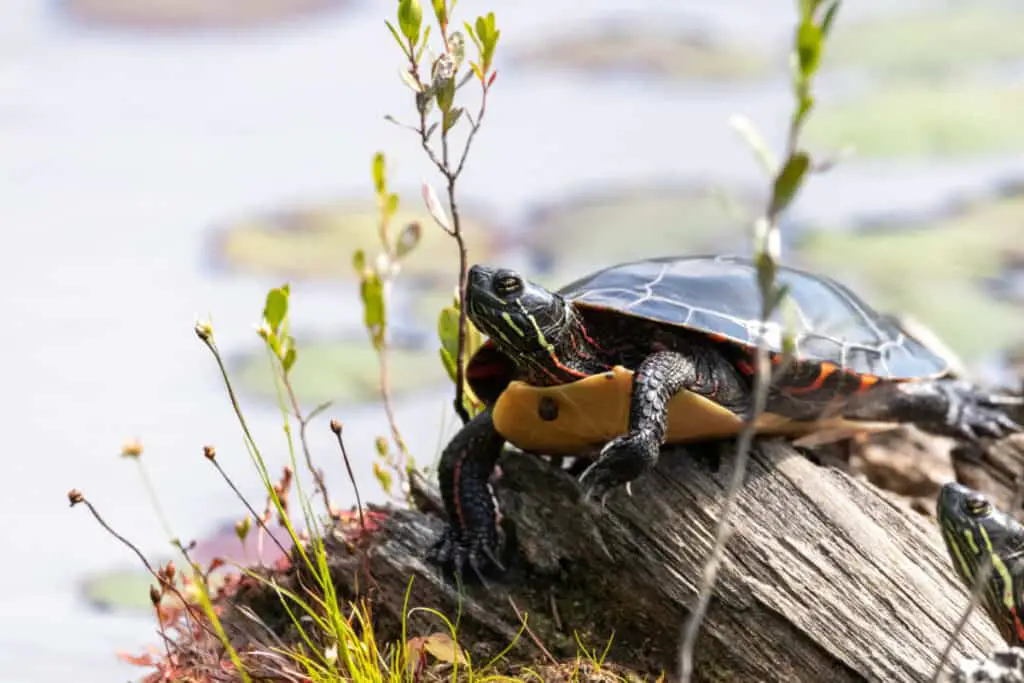
Scientific Name: Chrysemys picta picta
Description: Painted turtles are colorful turtles with a distinctive yellow-olive carapace with red or orange stripes. Their skin, head, and limbs have distinctive red or orange stripping.
Painted turtles’ habitat is freshwater bodies such as ponds, swamps, marshes, rivers, and other slow-moving water bodies with dense vegetation. This vegetation acts as their food and also protects them against predators.
Size: They are mid-sized turtles, reaching an adult length of 10 inches.
Diet: They may occasionally feed on some small animals like insects, earthworms, and tadpoles.
Reproduction: Their reproduction cycle starts in March or April and ends in September. A female turtle lays about ten eggs in a clutch. These will take about 60 to 90 days to hatch. For the female turtles, sexual maturity is by the 10th year, while males mature earlier by the 6th year.
Lifespan: Painted turtles have a relatively short lifespan of 20 years.
4. Southern Painted Turtle
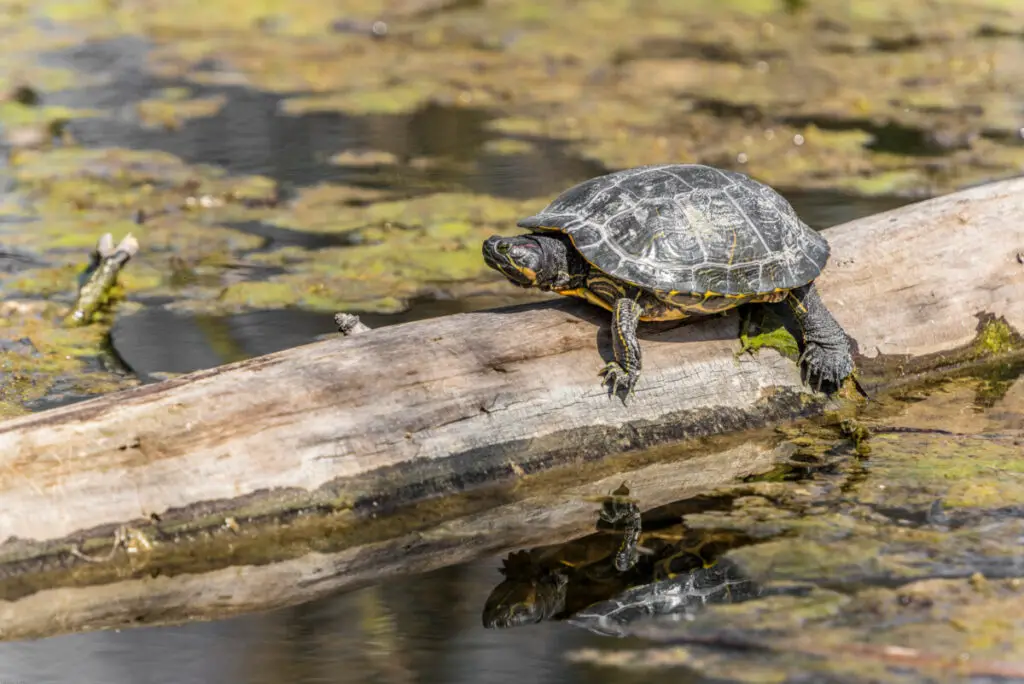
Scientific Name: Chrysemys picta dorsalis
Description: They have a smooth olive or green carapace with an orange keel. On the shell edges, the turtle has orange patches. The turtle’s plastron is reddish-orange and is hinged.
Southern painted turtles are commonly found in slow flowing-clear freshwater environments. These habitats may include rivers, ponds, lakes, swamps, and marshes with dense vegetation cover.
Size: This turtle is the smallest of the painted turtle species in Alabama. An adult turtle measures between 4 and 5 inches.
Diet: These turtles are omnivores, and their diet include vegetation, earthworms, fruits, berries, tadpoles, insects, and small fish.
Reproduction: Reproduction in southern painted turtles starts in March and ends in August or early September. A female turtle lays on average six eggs per clutch (a maximum of 2 clutches) between March and June. Incubation then takes between 70 and 80 days to hatch.
Lifespan: Southern painted turtles may live for up to 50 years.
5. Ouachita Map Turtles
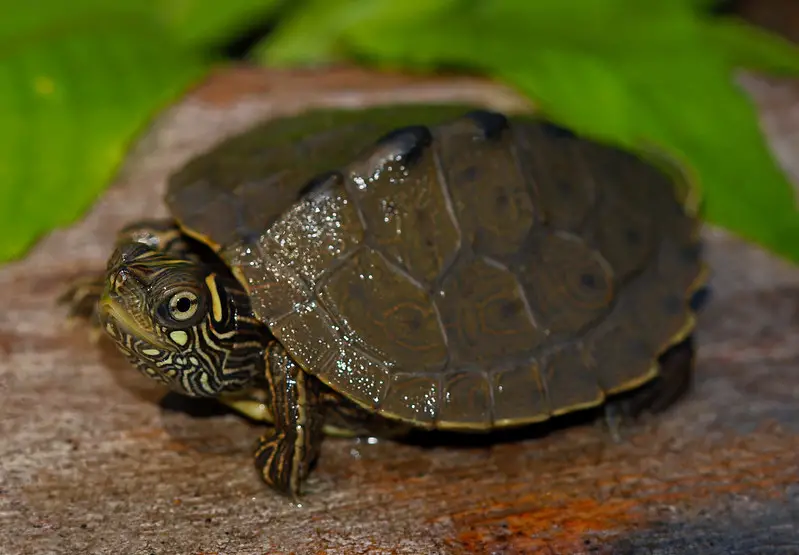
Scientific Name: Graptemys ouachitensis.
Description: Their name stems from the topographical map patterns on their carapace. They have a light spot behind each eye. They reside in fast-flowing rivers and streams that combine to form the Mississippi River. They also prefer water bodies with soft sandy floors as opposed to rocky ones.
Size: Ouachita map turtles are medium-sized turtles, with females reaching 9.5 inches long while males grow up to 5.5 inches.
Diet: This turtle eats both plants and meat, and its diet consists of worms, insects, aquatic plants, tadpoles, and dead fish.
Reproduction: This turtle is active between March and November. A female turtle will lay between 4 and 12 eggs by June. Incubation then starts and lasts for about 70 days. Eggs hatch towards mid-September. After hatching, the hatchlings may leave or overwinter in the nest.
Lifespan: Ouachita map turtles have a lifespan of between 30 and 50 years.
6. Alabama Map Turtle
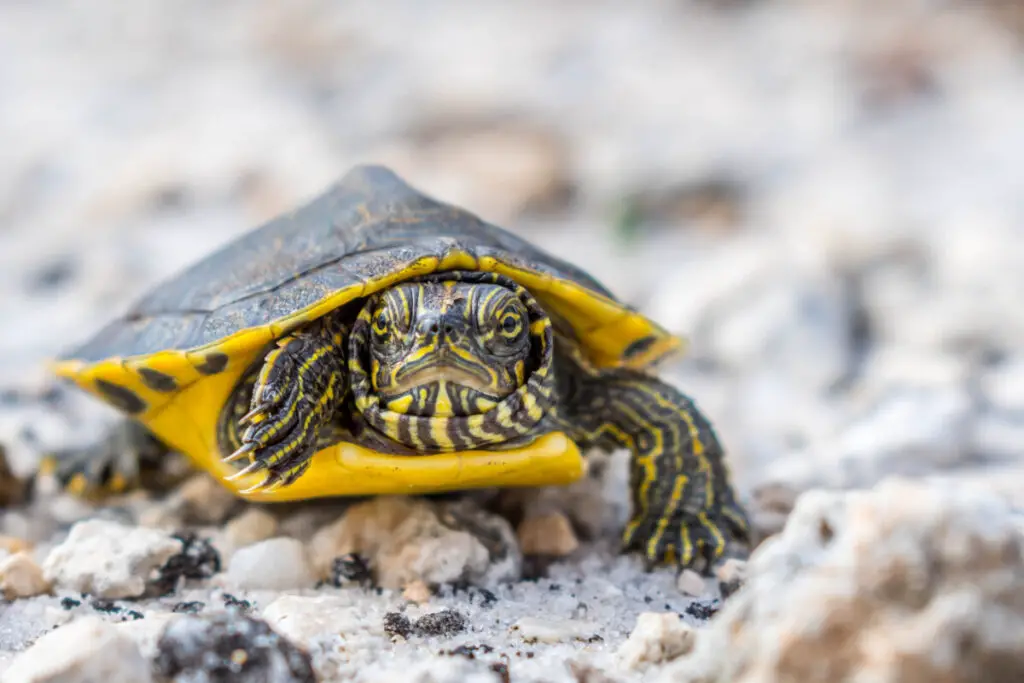
Scientific Name: Graptemys pulchra.
Description: They have a brown carapace, a prominent vertebral keel, and a distinctive yellow or olive spot behind each eye. The skin of the turtle is olive or brown with many yellow stripes.
These turtles are found in habitats with muddy or sandy bottoms, or sometimes rocky creeks and well-vegetated river banks.
Size: This turtle is mid-sized, with females being bigger than males at an average length of 10 inches. Males, on the other hand, measure between 3 and 5.5 inches.
Diet: Alabama map turtles are omnivorous but lean more toward meat as they grow older. Juveniles will mainly feed on plant matter, while adult turtles’ diet includes snails, insects, tadpoles, earthworms, and small fish.
Reproduction: Alabama map turtles achieve sexual maturity after 14 years. Female turtles will lay about six eggs in a clutch and a total of 4 clutches each year. Incubation in these turtles lasts for 70 and 80 days.
Lifespan: The lifespan of Alabama map turtles is 50 years in the wild.
7. Black-knobbed Map Turtle
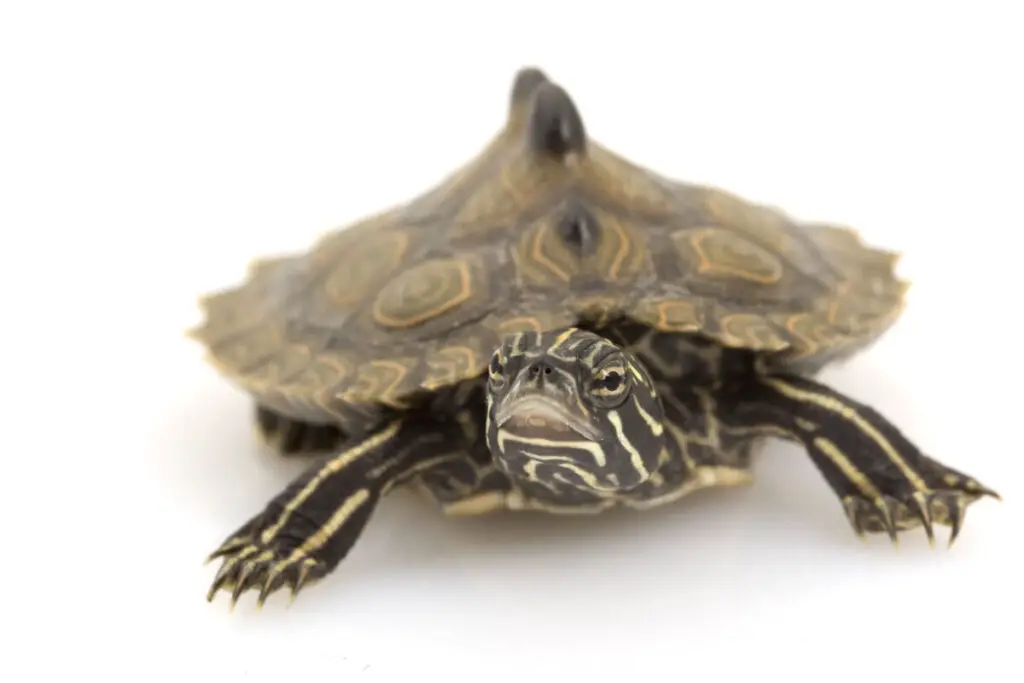
Scientific Name: Graptemys nigrinoda
Description: While its common name is derived from the knob-like projections on the carapace. The knobs form part of its vertebral keel. This black-knobbed turtle has a dark olive carapace, while its plastron is yellow with several red or black markings.
These turtles are found in water bodies with muddy floors, moderate current, and debris like dead wood and branches.
Size: This turtle is a small to medium-sized turtle measuring 3.5 and 8.75 inches long.
Diet: Their diet is mainly carnivorous, and it is composed of mollusks, crustaceans, insects, and small fish.
Reproduction: Reproduction in these turtles starts earlier in males than females. Males start reproducing by the 5th year, while females begin by the 9th year. About seven eggs are laid and incubated each season. Incubation takes about 65 days.
Lifespan: These turtles have one of the shortest time lifespans at just 15 years.
8. Barbour’s Map Turtles
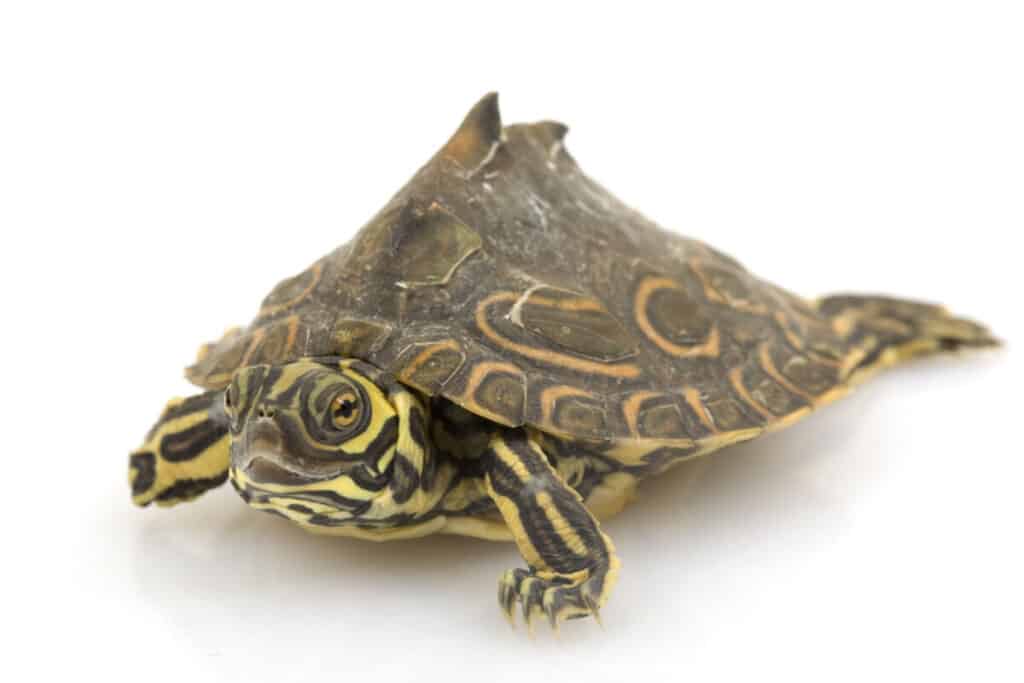
Scientific Name: Graptemys barbouri.
Description: It is among the threatened species in Alabama. The carapace ranges from tan-olive to a light yellow, while the skin, head, and limbs are stripped olive and yellow.
These turtles’ habitats are exclusively in rivers and other associated water bodies, preferring exposed areas with rocks and stumps for basking.
Size: They are small to mid-sized turtles. Females will grow up to 12 inches while males only achieve a mere 5 inches. A distinguishing feature between males and females is the females’ larger heads than the males.
Diet: The Barbour’s map turtle diet consists mainly of insects, larvae, snails, and other small aquatic animals.
Reproduction: The turtle’s reproductive age is four years in males and up to fifteen years in females. A female turtle will lay about 11 eggs in a clutch. Incubation lasts for about two and half months, with hatching occurring in late August or September.
Lifespan: The lifespan of these turtles is about 20 to 30 years.
9. Escambia Map Turtle
Scientific Name: Graptemys ernsti.
Description: Their carapace is keeled and is olive or dark brown. The head, skin, and limbs are olive with stripes of a light color.
The habitat of the Escambia map turtle is primarily south Alabama in rivers with loose sandy floors.
Size: The turtle measures between 3 and 12 inches long, with females being bigger than males.
Diet: Their diet is primarily composed of insect larvae, mussels, and clams.
Reproduction: Breeding in the Escambia turtles begins at age 3 for males and age 14 for females. Nesting happens from May and peaks in June. A female turtle often lays between 5 and 8 eggs in a clutch and may lay up to 4 clutches in one season.
Lifespan: The longevity of these turtles is about 50 years in the wild. They are considered a threatened species.
10. Diamond-Backed Terrapin
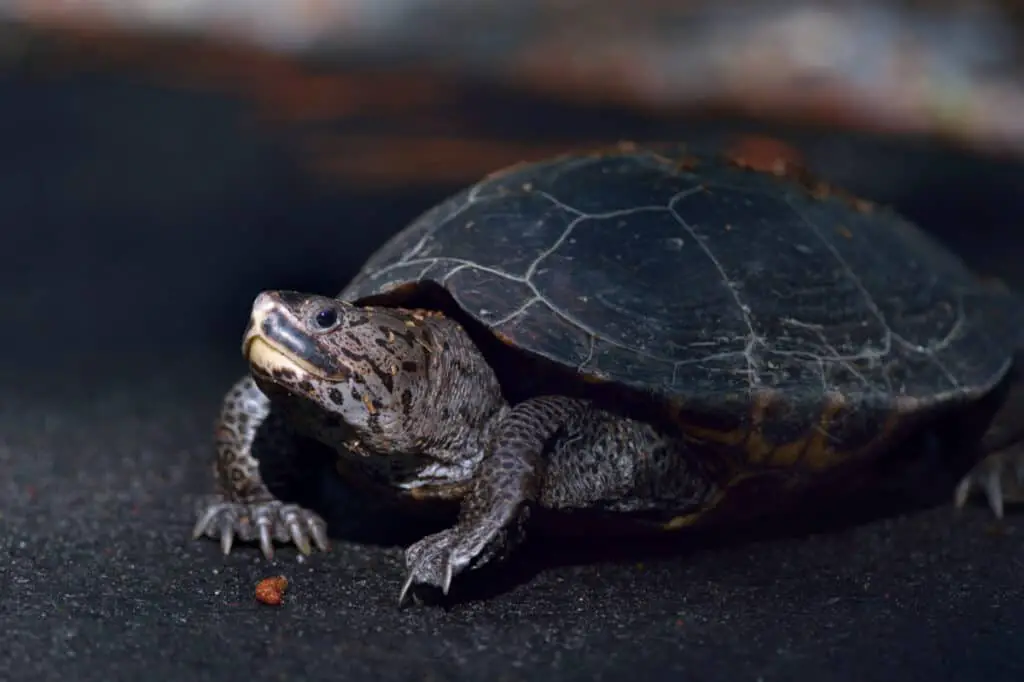
Scientific Name: Malaclemys terrapin pileata
Description: It has an oval, gray or black carapace with large, conspicuous growth rings that resemble diamonds. The plastron has a yellowish-creamy color with dark spots.
Their habitat consists of brackish waters with saline conditions, including coastal salt marshes, tidal creeks, and estuaries. Diamond-backed terrapins may also spend some time in freshwater streams or rivers.
Diamond-backed terrapins are highly endangered species as a result of habitat degradation.
Size: Like most turtles in Alabama, it is mid-sized, measuring between 5.5 and 9 inches.
Diet: Since they are carnivores, their primary food source includes snails, carrion, fish, crabs, marine annelids, mollusks, and crustaceans.
Reproduction: Egg-laying starts in April or May when the female turtles are at least six years. About 5 to 12 eggs are deposited in the nests that the turtles dig on the beach. Incubation takes between 70 and 90 days.
Lifespan: The turtles may live to 40 or 50 years.
11. River Cooters
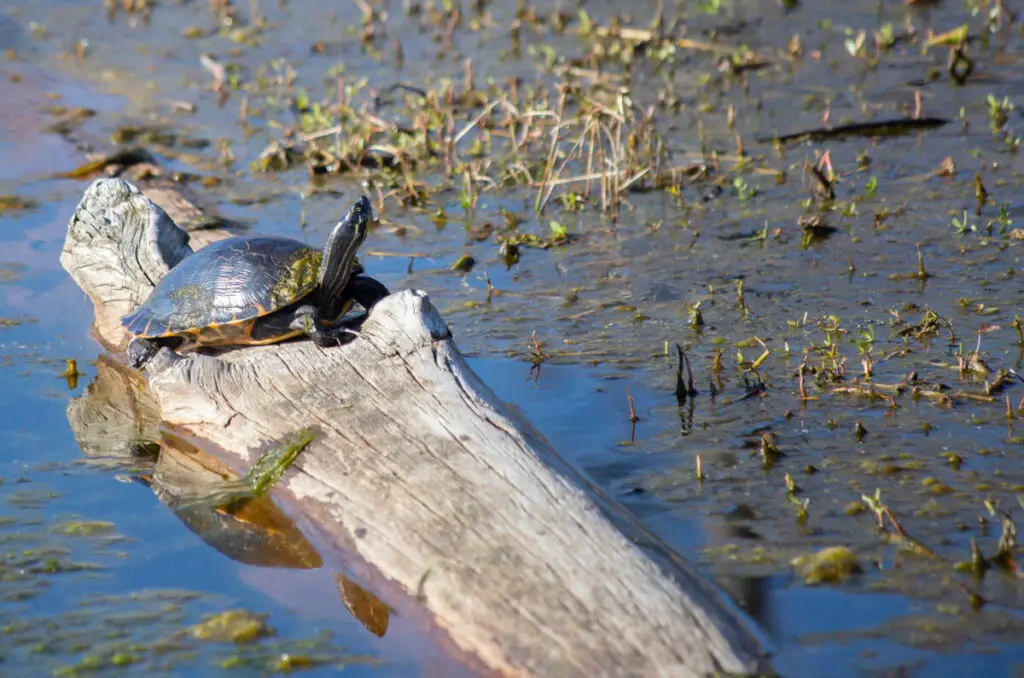
Scientific Name: Pseudemys concinna.
Description: They have a relatively flat carapace that is olive or brown and has numerous cream or yellow markings. These turtles have a vertebral keel, and their plastron has well-developed black patterns.
River cooters inhabit both freshwater and brackish habitats and are common in rivers, ponds, or marshes with a dense vegetation cover. They enjoy basking and are usually in the company of red sliders.
Diet: Their diet is primarily made up of insects, mollusks, aquatic plants, algae, and crustaceans.
Reproduction: Reproduction in river cooters occurs between March and September. Female turtles will lay eggs by June. Incubation then commences and lasts for about 90 days. About 10-20 eggs are laid in a single clutch. Sexual maturity in female river cooters is achieved by the 13th year.
Lifespan: Their lifespan is about 40 years in the wild.
12. Coastal Plain Cooter
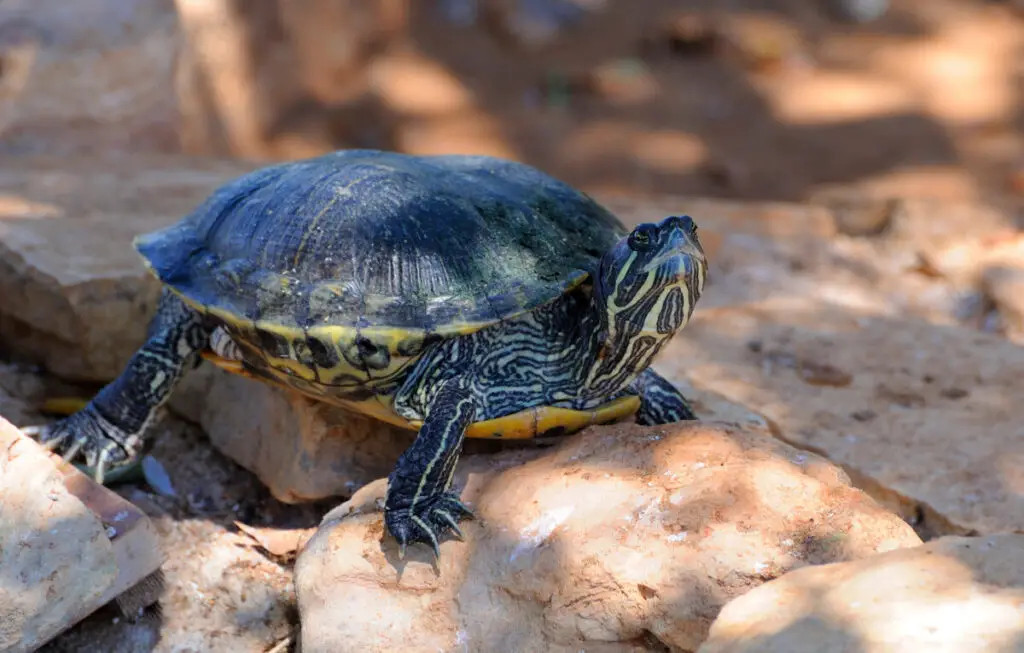
Scientific Name: Pseudemys floridana.
Description: The carapace is serrated along the posterior margin and ranges from greenish-yellow to brown with some yellowish margins. Its plastron, on the other hand, has a plain yellowish color.
Coastal plain cooters inhabit slow-flowing water bodies with soft floors such as ponds, marshes, lakes, and big swamps. They prefer areas with dense and dead vegetation for basking.
Size: It is one of the largest turtles among the cooter species. A mature adult turtle measures up to 15 inches.
Diet: These turtles are primarily herbivores and will eat large quantities of aquatic vegetation. Occasionally, they will feed on aquatic insects and their larvae.
Reproduction: Nesting in plain cooters occurs between May and June, where the females lay between 10 and 20 eggs. These eggs are then incubated for about 80-100 days.
Lifespan: Their lifespan is about 45 years in the wild.
13. Alabama Red-Bellied Cooter
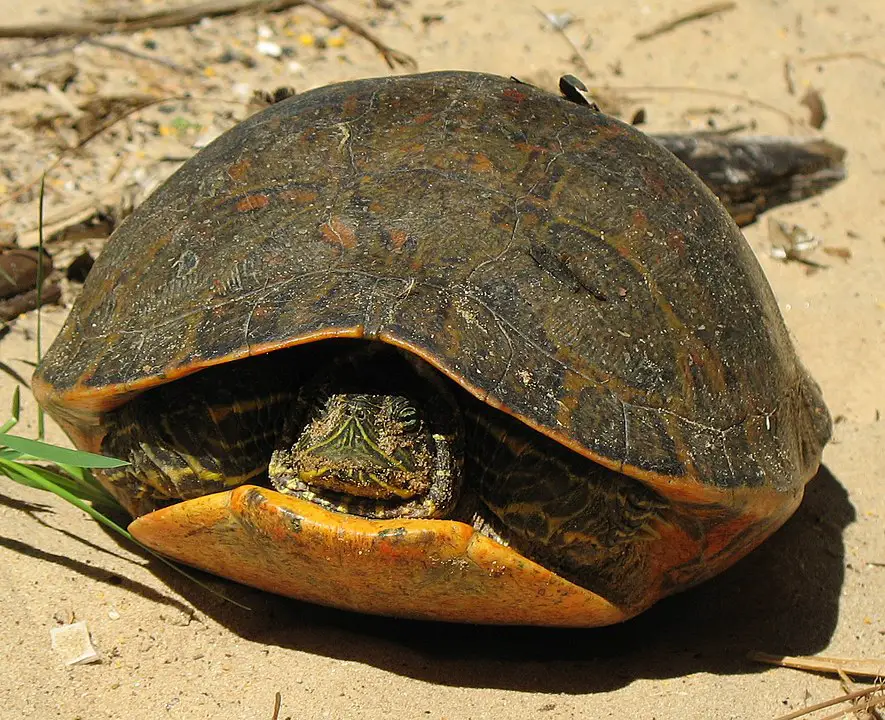
Scientific Name: Pseudemys alabamensis.
Description: It has been Alabama’s state reptile since 1990. The name is derived from the red coloration found on its plastron.
It has a greenish or dark brown carapace with red, yellow, or orange markings on the edges. Reddish or yellowish stripes characterize the head and limbs.
Their habitat is primarily made of slow-flowing water bodies with soft floors. It may also be found in brackish streams or rivers.
These turtles are among the most critically endangered in Alabama.
Size: It is a relatively big turtle with adults reaching up to 12 inches long.
Diet: They are herbivorous, with their diets composed of vegetables and aquatic plants.
Reproduction: Females are known to lay their eggs between April and August. About nine eggs are laid in a single instance. Hatchlings start emerging in October but may be forced to overwinter in the nest if hatching is delayed.
Lifespan: A healthy turtle may live up to 50 years.
14. Pond Slider
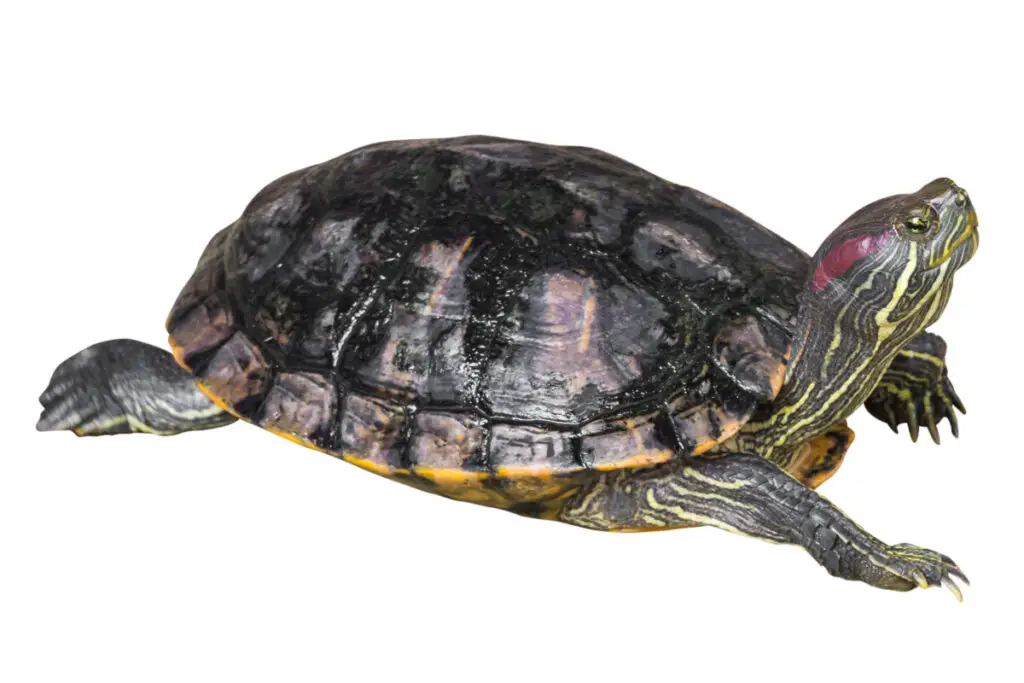
Scientific Name: Trachemys scripta.
Description: There are three subspecies of pond sliders: Red-eared sliders, Yellow-bellied sliders, and the Cumberland sliders. Of all these, the Red-eared slider is the most widespread.
The carapace usually has a pattern of concentric rings and may have green, black and brown sections. A distinguishing feature is the red or yellow markings on the plastron.
Pond sliders are semi-aquatic, meaning part of their lives is spent on land, especially when basking. They are common in rivers and ponds with lots of vegetation and dead debris for basking.
Size: They are small-sized turtles measuring between 5 and 8 inches when fully grown.
Reproduction: Reproduction in pond sliders happens from the age of 5 years in females. Nesting occurs between May and July, where female turtles will lay between 4 and 23 eggs. It takes about 60 to 80 days for the eggs to hatch.
Lifespan: These turtles will live for about 42 years in the wild.
15. Spiny Softshell Turtle
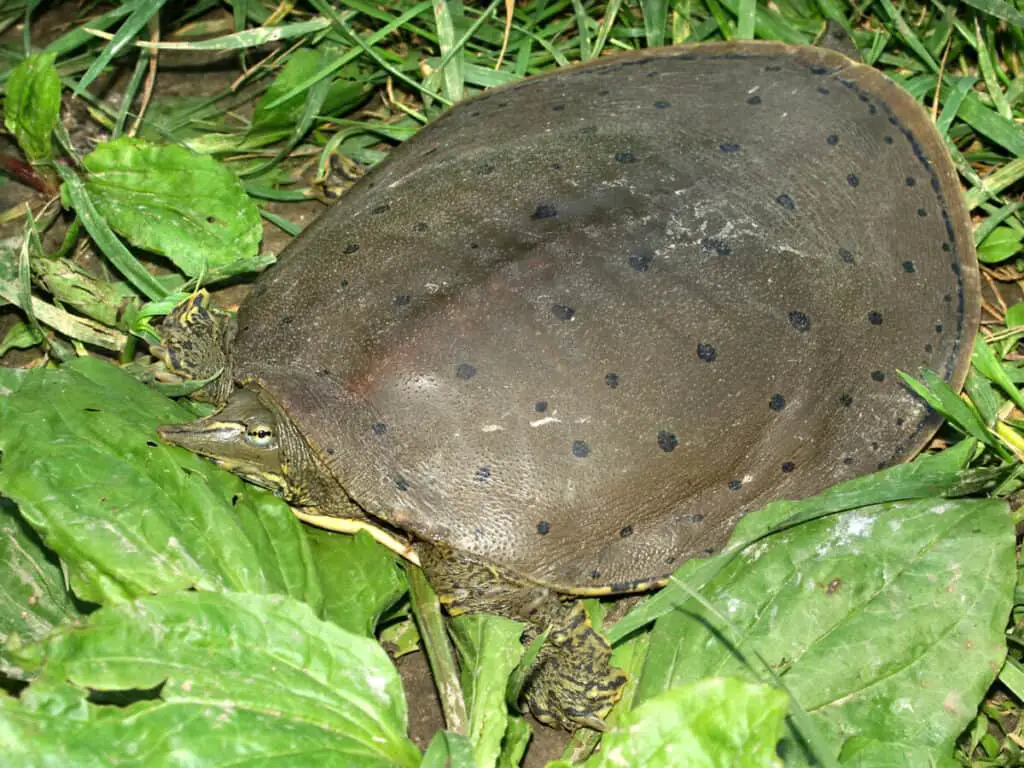
Scientific Name: Apalone spinifera.
Description: Their carapace is plain-looking, flat, soft, and leathery, with pointed appendages on the edges. The turtle’s appearance is plain gray, brown, or olive with some dark spots, while their mouths are pointed in a snout-like shape.
This turtle is common in lakes, rivers, and streams with sandy or muddy floors in Alabama. They are also excellent swimmers.
Size: It is a large-sized turtle, growing up to 21 inches long.
Diet: Their diet is mainly composed of insects, crayfish, crustaceans, mollusks, and small fish.
Reproduction: Breeding in these turtles occurs in May. A female turtle will lay between 4 and 38 eggs on loose soil. Incubation takes about 80 to 90 days, and hatchlings start emerging in September.
Lifespan: The turtle can live up to 50 years in the wild and longer if taken care of well in captivity.
16. Smooth Softshell Turtle
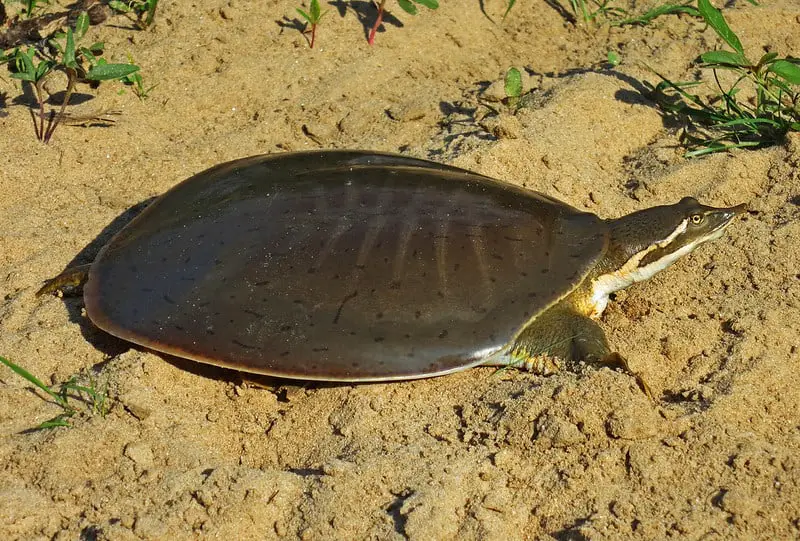
Scientific Name: Apalone mutica.
Description: Like the spiny softshell, they have a leathery, flat, and smooth carapace but without the projection or spines on the edges.
Their carapace is plain olive or brown, while their heads have a light-colored stripe behind each eye.
They are common in larger, fast-flowing water bodies like rivers, lakes, and large streams as they are excellent swimmers. Pollution in these water bodies is their biggest threat.
Size: When mature, this turtle measures between 11 and 15 inches long.
Reproduction: Breeding in smooth softshell turtles happens between April and June and ends with hatchlings emerging in September. Female turtles will lay only one clutch in a year containing between 15 and 25 eggs. The eggs will hatch after 60 to 90 days. Sexual maturity is achieved by the 9th year in females.
Lifespan: Their lifespan is relatively short, at only 20 years in the wild.
17. Eastern Mud Turtle
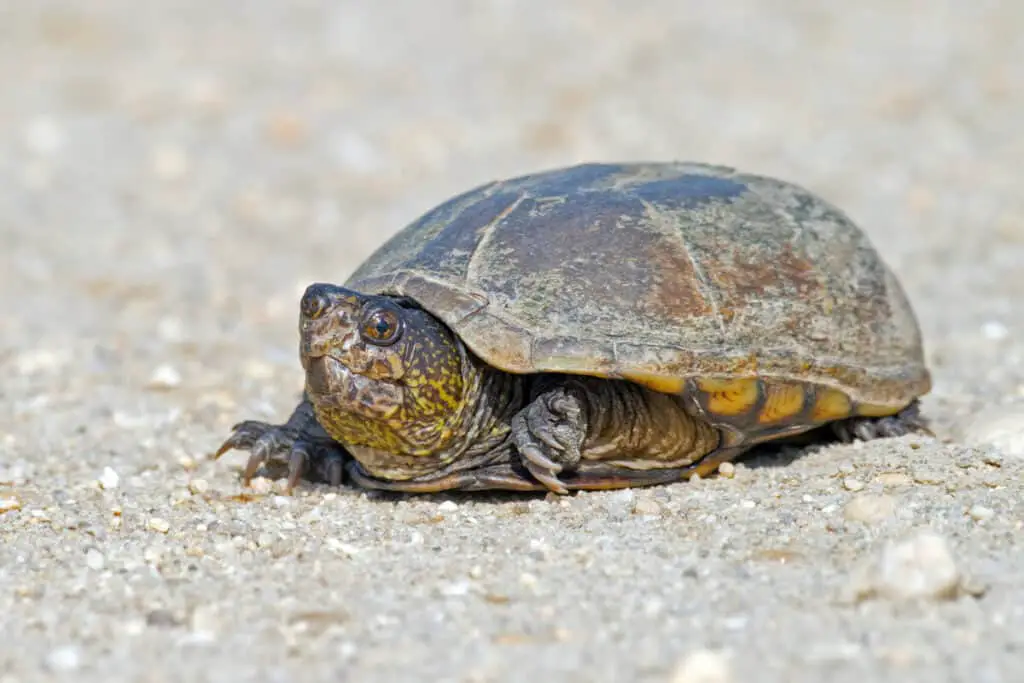
Scientific Name: Kinsternon subrubrum.
Description: It has a smooth carapace which is black or olive, while the plastron is yellowish-brown with dark markings.
Eastern mud turtles are common in shallow waters with mud or sandy floors. They are common in ditches, meadows, marshes, and swamps.
Size: They are among the smallest turtles in Alabama, with the adults measuring between 3 and 5 inches.
Diet: Like many other turtles, their diet mainly consists of mollusks, aquatic vegetation, seeds, crustaceans, and small fish.
Reproduction: Reproduction in Mud turtles occurs between June and September. Female turtles will lay between 2 and 5 eggs in June. In about 60 to 80 days, hatchlings start emerging. An interesting fact is that eastern mud turtles do not hibernate during the cold months.
Lifespan: The lifespan of mud turtles is about 40 years in the wild.
18. Eastern Musk Turtle
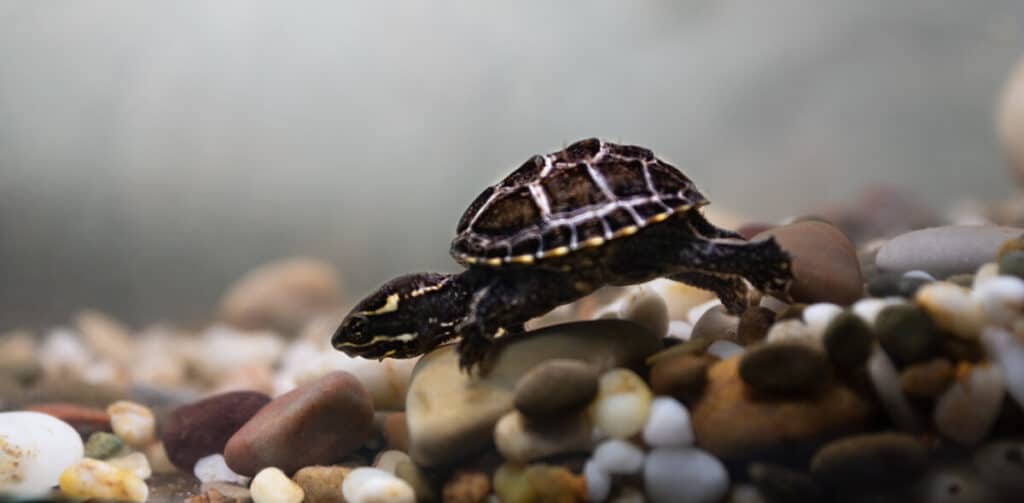
Scientific Name: Sternotherus odoratus.
Description: They are nicknamed ‘stinkpots’ owing to the strong odor they produce from their musk glands when threatened.
The carapace ranges in color from olive to black with irregular dark patterns.
Eastern musk turtles are common in slow-flowing streams, rivers, and other water bodies with soft or sandy floors.
Size: Musk turtles are small-sized, measuring between 2 and 4 inches.
Diet: They are primarily omnivorous, and their diet is made of snails, crabs, algae, insects, beetles, moths, crayfish, and other aquatic plants.
Reproduction: Eastern musk turtles reproduce from three years for the males and four years for the females. Female turtles can lay up to 2 clutches per year, each holding five eggs on average. Incubation in these turtles starts right after eggs are laid and takes about 60 to 85 days. The hatchlings start emerging by late August.
19. Flattened Musk Turtle
Scientific Name: Sternotherus depressus.
Description: As their name suggests, they have a flattened carapace with overlapping scutes.
These turtles are live almost exclusively in freshwater bodies. These include clean water systems, streams, rivers, and other water bodies with plenty of rock cover for basking.
The turtle is found exclusively in Alabama, in the Black Warrior region. This turtle is considered to be critically endangered.
Size: They are small, measuring between 3 and 4 inches when fully grown.
Diet: Their diet mainly consists of freshwater snails, clams, aquatic insects, and their larva.
Reproduction: During reproduction, which happens between May and September, a female turtle will lay a maximum of two clutches, each containing up to 5 eggs. The laying of eggs happens in May and June. The incubation period is not very well known, but it is thought to last between 45 and 70 days.
20. Razorback Musk Turtle
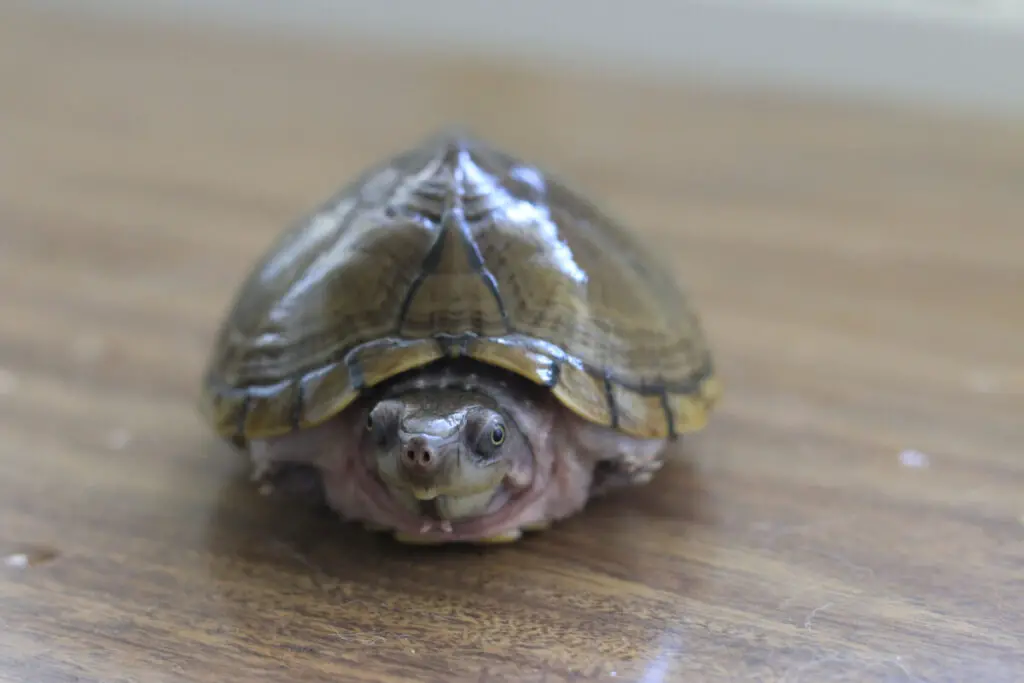
Scientific Name: Sternotherus carinatus.
Description: Razor-backed musk species has a brown carapace with a prominent vertebral keel. It also has dark markings along the edges of the scutes. Its skin is light grey, and its head terminates in a pointed tip.
They spend all their lives in water, only leaving to lay eggs. They prefer deep water bodies like oxbow lakes, rivers, swamps, and large streams with slow-flowing water.
Size: It is a tiny turtle achieving a maximum length of 5 inches but is the biggest of all musk turtles.
Diet: Their diet is primarily fish, snails, aquatic insects and frogs, crustaceans, snails, and clams.
Reproduction: Reproductive maturity in these turtles is achieved by the 8th year of life for females. By May, a female turtle will lay up to 3 clutches, each containing at least three eggs. Incubation takes about 60 days, and hatchlings start emerging from the nest by the end of August.
Lifespan: Their lifespan is about 25 years.
21. Loggerhead Musk Turtle
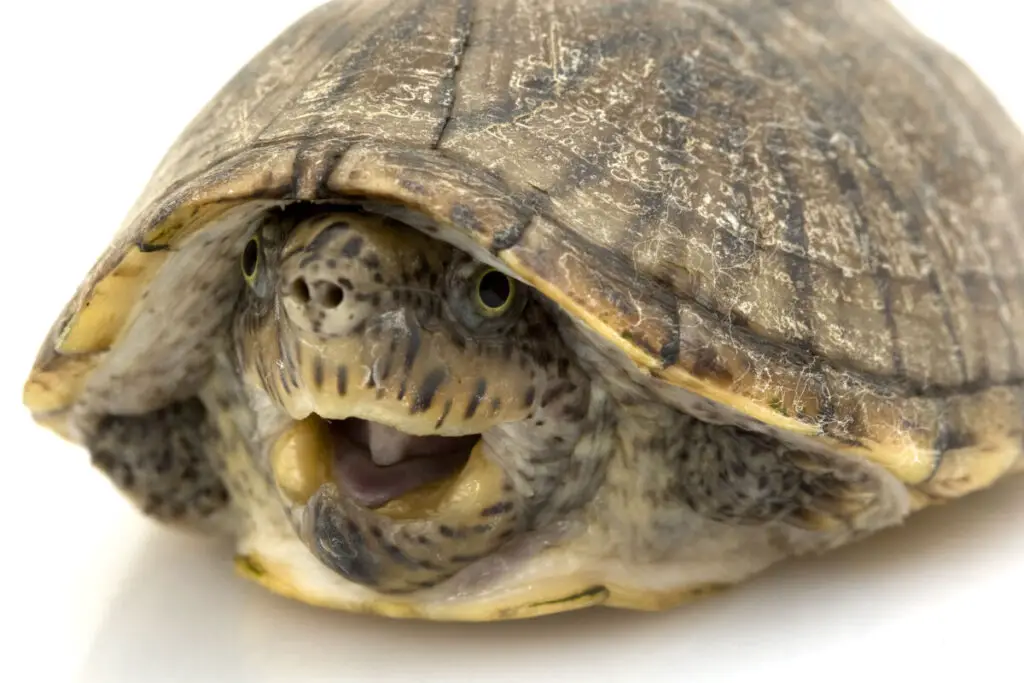
Scientific Name: Sternotherus minor.
Description: A distinguishing feature in loggerhead Musk turtles is their yellowish-brown carapace with numerous dark spots, with males having larger heads than females.
They are common in springs and other water bodies with muddy bottoms and dense vegetation to forage on as they rest.
Size: It is a small turtle measuring 4.5 inches when mature.
Diet: Their diet consists of crabs, crayfish, clams, snails, small fish, crustaceans, and aquatic plants.
Reproduction: Sexual maturity is achieved by the 4th year in males and the 8th year in females. After mating underwater, the females proceed to land to lay their eggs. About two clutches are laid each year, each containing five eggs. Incubation in loggerhead musk turtles takes about 60 to 100 days.
Lifespan: Their lifespan is about 20 years in the wild.
22. Chicken Turtle
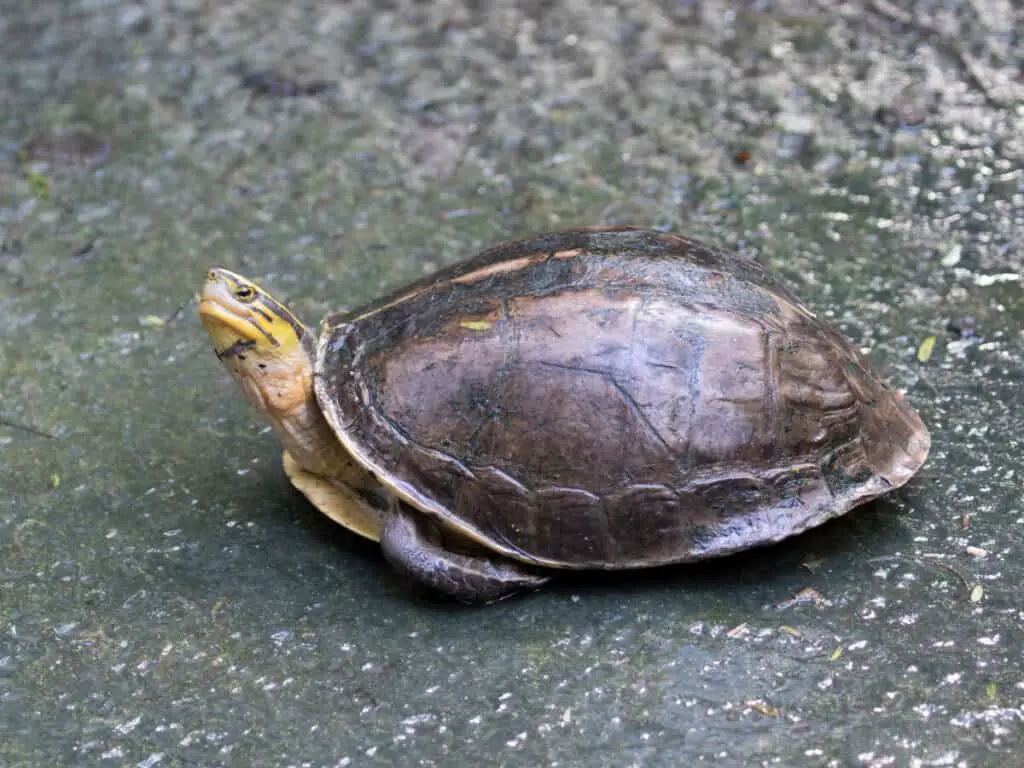
Scientific Name: Deiochelus reticularia.
Description: Their carapace ranges from brown to black with some patches of yellow or orange. Their lower body is olive or black with numerous yellow or orange stripes.
Chicken turtles are common in still water, ponds, marshes, and ditches with dense vegetation for foraging.
Their name is derived from the taste of their meat. This turtle is a famous delicacy among the turtle-eating community, contributing significantly to the decline of its numbers. Currently, this turtle is listed as endangered species.
Size: When mature, they measure between 4 to 6 inches long.
Diet: These turtles are primarily omnivorous, feeding on aquatic vegetation, insects, larva, amphibians and their eggs, and crayfish.
Reproduction: Reproduction occurs between March and September, with a female turtle laying between 7 and 19 eggs in a clutch. She may lay up to 2 clutches each year. Sexual maturity in females is achieved by the 5th year.
Lifespan: The lifespan of this species is up to 25 years.
The other two categories of turtles in Alabama are as below:
Box Turtles
There are three species in Alabama, namely:
23. Eastern box turtle
24. Three-toed box turtle
25. Gopher tortoise
The gopher tortoise is the only terrestrial turtle in Alabama.
Sea Turtles
As the name suggests, sea turtles are the turtles that are found in the sea. There are five species and are listed below;
26. Leatherback
27. Green sea turtle
28. Loggerhead
29. Hawksbill
30. Kemp’s ridley
Laws Governing Turtle Keeping In Alabama
Like any other state with turtles, Alabama has laws governing turtles’ possession, sale, and disposal. Below are some of these laws:
- It is unlawful to take possession, sell, kill, or capture the seven protected turtles in Alabama from the wild. These turtles are Gopher Tortoise, Alabama Red Belly, Alligator Snapper, Alabama Map, Black Knobbed Sawback, Flattened Musk Turtle, or Escambia Bay Map.
- One can possess any native turtle that is not endangered or protected. It is, however, unlawful for an individual or a corporation to import or purchase an imported non-native turtle species for the purposes of propagation.
- It is also against the law for one to disturb or damage a sea turtle’s eggs or nest.
- It is unlawful to take possession or sell a common snapping or the softshell turtle with a carapace length below 8 inches. The law declares it illegal to have more than two turtles of the unprotected species for personal use.
- The following are the approved ways of handling a turtle; dip net, by hand, or by hook and line to protect turtles from injury when being captured. The rules are for both public and private waters.
- To own or transfer a box turtle, one is required to possess a special permit. The permit only allows a maximum of one box turtle per person.
- It is illegal to release unwanted turtle pets to the wild. It is also unlawful to capture a turtle from the wild. Turtles should be handed over to the authorities when one no longer wants them. Also, turtles should only be obtained from people recognized and authorized by the authorities to trade in turtles. This law also applies to both turtle eggs and hatchlings.
- It is illegal to trade turtles without a turtle dealer or a turtle farmer permit. One is also forbidden from selling turtles that have been captured from the wild. It is also illegal to commercialize turtle eggs.
- It is illegal to commercialize the protected, endangered, or vulnerable turtle species in Alabama. One is also not allowed to own endangered species unless under stringent regulations.
- Since sea turtles have their nests on the beach, making any major changes in these areas is illegal. It is unlawful to access nesting areas that have been sealed off from the public during the nesting period.
- To study sea turtles, one will need to have a state-issued service permit. This permit is necessary if one needs to remove a specimen from the wild for study. That permit may allow one to have the turtles in captivity. The turtles should be taken to a holding facility as per the permit authorization.
Frequently Asked Questions
Which is The Commonest Turtle in Alabama?
The most abundant turtle species in Alabama is the box turtle. Although there are only three species in Alabama, they are common in most turtle habitats in Alabama. It is not uncommon to find box turtles in the company of other turtles.
Are There Tortoises in Alabama?
The gopher turtle is the only tortoise species in Alabama. It is a native turtle, and it is common in about 67 counties in Alabama. A tortoise is a turtle that lives exclusively on land. It is worth noting that the gopher turtle is threatened and is among the protected turtles in Alabama.
Can One Keep Box Turtles as Pets in Alabama?
In Alabama, it is illegal to possess, buy or trade a box turtle or its products like eggs. It is also unlawful to take these turtles from the wild and keep them as your pets.
Can I Release My Turtle Pets to The Wild?
In Alabama, it is unlawful to release your pets to the wild when you no longer want them as pets. This is because the conditions in the wild and those in captivity are very different, and as a result, the turtle may not survive. In other cases, these turtles might breed quickly, thus putting a strain on the existing resources.
What is The Most Active Period for Alabama Turtles?
Turtles are primarily active during the period between May and September. This is also considered the breeding period for most turtles. Once the breeding period is through and the female turtles have laid their eggs in the nests, most turtles will overwinter.
Conclusion
Alabama is one of the US states that have the highest number of turtle species. There are freshwater turtles, sea turtles, and box turtles. Some of the turtles from the above lists are very similar in appearance and behavior, making it hard to distinguish between them. Some even occupy the same habitat and compete for the same prey.
From the list, we have also observed that several turtle species are facing the threat of extinction. The single most threat to the turtle population is human activities in their habitats and hatching areas. Such activities disturb the ecosystem of these turtles, which may lead to injury in turtles, starvation, and exposure to predators.
The turtle laws of Alabama have helped a great deal in fighting the threat of extinction in turtles. However, there is still a lot that needs to be done to sensitize people to take care of the turtles. By becoming aware of the plight of the turtles, people will be more mindful of their welfare and thus take care of them.
Learn more about other turtle species:
- Turtles In Oklahoma (17 Species Guide)
- Turtles In Maryland (Full Guide With Pictures)
- Florida Turtles Guide (Full Guide With Pictures)
- Kentucky Native Turtles (17 Species With Pictures)
- Indiana Native Turtles (Ultimate Guide With Pictures)
- Michigan Native Turtles (10 Species with Pictures)
- 18 Native Turtles in Tennessee (Guide With Pictures)
- Common Turtles Species in Massachusetts
- Turtles In South Carolina (20 Species With Pictures)